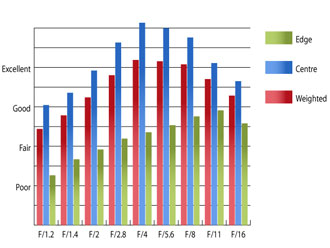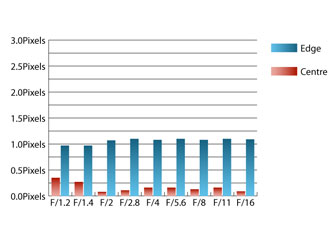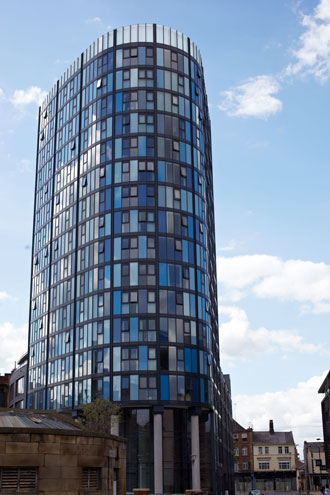Canon EF 50mm f/1.2L USM
Canon EF 50mm f/1.2L USM: Performance
At maximum aperture the sharpness in the centre is already good, but things aren't quite as clear towards the edges. This isn't a disaster for a lens like this, as the area in focus at f/1.2 will often be near the centre of the frame, isolated by the shallow depth of field.Although the sharpness in the centre improves dramatically as the lens is stopped down, the resolution towards the edges remains relatively low. This lens is a specialist optic, to be used for effect, rather than an all-purpose lens that will be as at home on a copy-stand as it may be taking portraits. By f/4 the sharpness in the centre is outstanding and all images taken with this lens during testing have a unique look to them.
| Resolution at 50mm | How to read our graphsThe blue column represents readings from the centre of the picture frame at the various apertures and the green is from the edges. Averaging them out gives the red weighted column.The scale on the left side is an indication of actual image resolution. The taller the column, the better the lens performance. Simple. For this review, the lens was tested on an Canon EOS 5D Mark II using Imatest. | |
 |
At their most severe, chromatic aberrations cover an area of 1.1 pixel widths around high contrast edges. On a high resolution sensor, like that found on the EOS 5D MkII, this level should pose few issues, even at very large print sizes.
| Chromatic Aberrations at 50mm | How to read our chartsChromatic aberration is the lens' inability to focus on the sensor or film all colours of visible light at the same point. Severe chromatic aberration gives a noticeable fringing or a halo effect around sharp edges within the picture. It can be cured in software.Apochromatic lenses have special lens elements (aspheric, extra-low dispersion etc) to minimize the problem, hence they usually cost more. For this review, the lens was tested on an Canon EOS 5D Mark II using Imatest. | |
 |
Imatest detected 2.5% barrelling, which isn't an overly high level of distortion, but may pose issues for critical applications. However, this distortion is uniform across the frame, so it should be straightforward to correct in image editing software afterwards.
The deeply recessed front element is well-protected against extraneous light, even without the supplied circular hood attached, which makes the lens resistant to flare caused by light sources just outside the frame. When shooting directly into the light, contrast can drop quite severely, especially when shooting at maximum aperture.
Add your message
Login required
Please login here or if you've not registered, you can register here. Registering is safe, quick and free.
Please login here or if you've not registered, you can register here. Registering is safe, quick and free.
photodo Stats
1102 lenses
428 MTF tests
74 in-depth photodo reviews
100+ users join each day
Help the lens community by reviewing or rating a lens today via our lens search
428 MTF tests
74 in-depth photodo reviews
100+ users join each day
Help the lens community by reviewing or rating a lens today via our lens search
Latest Lens Reviews
- Chinon 28mm f/2.8 Vintage Lens Review
- Canon EF 70-200mm f/4L IS II USM Lens Review
- Samyang AF 85mm f/1.4 EF Review
- Sigma 70mm f/2.8 DG Macro Art Review
- Samyang AF 24mm f/2.8 FE Review
- Meike 50mm f/1.7 Review
- Tamron 70-210mm f/4 Di VC USD Review
- Lensbaby Burnside 35mm f/2.8 Review
- Asahi Super Takumar 50mm f/1.4 Review
- Asahi Super-Multi-Coated Takumar 135mm f/3.5 Review








